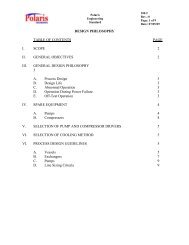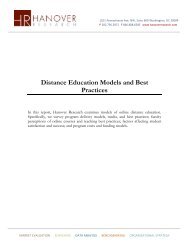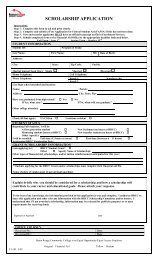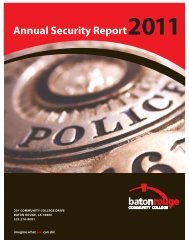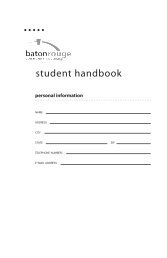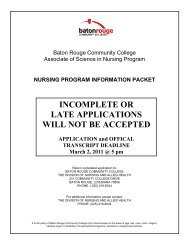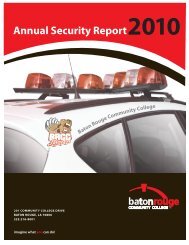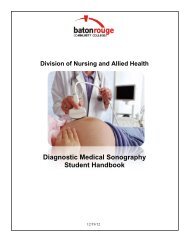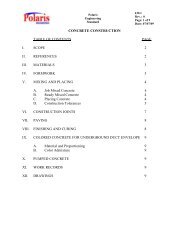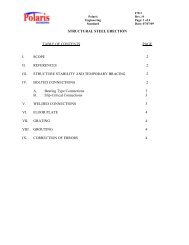General welding, fabrication and inspection table of contents page
General welding, fabrication and inspection table of contents page
General welding, fabrication and inspection table of contents page
You also want an ePaper? Increase the reach of your titles
YUMPU automatically turns print PDFs into web optimized ePapers that Google loves.
Polaris<br />
Engineering<br />
St<strong>and</strong>ard<br />
140.10<br />
Rev.: 0<br />
Page: 1 <strong>of</strong> 24<br />
Date: 07/06/09<br />
GENERAL WELDING, FABRICATION AND INSPECTION<br />
TABLE OF CONTENTS<br />
PAGE<br />
I. SCOPE 2<br />
II. REFERENCES 2<br />
III. WELDING PROCEDURES 3<br />
IV. WELDING PROCESSES (GENERAL) 4<br />
V. WELDING PROCESS LIMITATIONS 5<br />
VI. FILLER MATERIALS AND FLUXES 6<br />
VII. WELD JOINT PREPARATION AND WELDING FABRICATION 9<br />
VIII. PREHEAT AND INTERPASS TEMPERATURES 13<br />
IX. POSTWELD HEAT TREATMENT 14<br />
X. NON-DESTRUCTIVE EXAMINATION, TESTING AND INSPECTION 17<br />
XI. REPAIRS 20<br />
XII. SUMMARY OF WELDING VARIABLE LIMITATIONS, 21<br />
RESTRICTIONS AND OTHER REQUIREMENTS<br />
XIII.<br />
PROCEDURE FOR REVIEW AND ACCEPTANCE OF<br />
VENDOR WELDING PROCEDURES 22<br />
APPENDIX I - WELD MAP 24
Polaris<br />
Engineering<br />
St<strong>and</strong>ard<br />
140.10<br />
Rev.: 5<br />
Page: 2 <strong>of</strong> 24<br />
GENERAL WELDING, FABRICATION AND INSPECTION<br />
I. SCOPE<br />
A. This St<strong>and</strong>ard covers the minimum <strong>welding</strong> requirements, for <strong>welding</strong> <strong>of</strong> shop<br />
<strong>and</strong> field <strong>fabrication</strong>s <strong>and</strong> the weld <strong>inspection</strong> <strong>of</strong> the following:<br />
1. Pressure containing equipment <strong>and</strong> piping, whether code stamped or not,<br />
including but not limited to: rotating equipment, boilers, pressure vessels,<br />
heat exchangers, air coolers, shop <strong>and</strong> field fabricated piping, fired heater<br />
tubes, storage tanks, stacks <strong>and</strong> their attachments.<br />
2. Equipment or piping containing toxic or corrosive materials.<br />
3. Structural Steel<br />
4. Other <strong>fabrication</strong>s where specified.<br />
B. This St<strong>and</strong>ard modifies the requirements <strong>of</strong> applicable ASME, AWS, API <strong>and</strong><br />
ANSI codes <strong>and</strong> st<strong>and</strong>ards in effect at the revision date.<br />
C. Conflicts between requirements <strong>of</strong> this St<strong>and</strong>ard, related specifications, st<strong>and</strong>ards,<br />
codes, purchase orders or drawings shall be clarified with Client or Client's<br />
Engineer (designated Contractor) prior to proceeding with the <strong>fabrication</strong> <strong>of</strong> the<br />
affected parts. Regarding conflicts, the Client reserves the right <strong>of</strong> final decision.<br />
D. Where conflicts exist between this Engineering St<strong>and</strong>ard <strong>and</strong> other POLARIS<br />
Engineering St<strong>and</strong>ards <strong>and</strong>/or applicable codes or regulations, the more stringent<br />
requirement shall govern. All conflicts shall be brought to the Client’s attention<br />
for resolution. The Client shall be the sole arbiter <strong>of</strong> any conflicts.<br />
II.<br />
REFERENCES<br />
This POLARIS St<strong>and</strong>ard is to be used in conjunction with the latest revision <strong>of</strong> the<br />
st<strong>and</strong>ards <strong>and</strong> codes listed below, unless specifically noted. The terminology "latest<br />
revision" shall be interpreted as the revision in effect at the time <strong>of</strong> contract award. This<br />
POLARIS St<strong>and</strong>ard may reference specific sections <strong>of</strong> some <strong>of</strong> these codes <strong>and</strong><br />
st<strong>and</strong>ards. The revision <strong>of</strong> the codes <strong>and</strong> st<strong>and</strong>ards being referenced is noted below in<br />
parenthesis. This information is provided to identify the subject matter being referenced.<br />
Changes or exceptions made to the referenced code or st<strong>and</strong>ard shall apply to later<br />
revisions as applicable.<br />
A. POLARIS Engineering St<strong>and</strong>ards
Polaris<br />
Engineering<br />
St<strong>and</strong>ard<br />
140.10<br />
Rev.: 5<br />
Page: 3 <strong>of</strong> 24<br />
3. 840.1 <strong>General</strong> Requirements For Pipe Fabrication<br />
B. National Codes <strong>and</strong> St<strong>and</strong>ards<br />
1. API American Petroleum Institute St<strong>and</strong>ards<br />
2. AWS American Welding Society St<strong>and</strong>ards<br />
3. ASME B16.5 Pipe Flanges <strong>and</strong> Fittings (1998)<br />
4. ASME B31.1 Power Piping (2001)<br />
5. ASME B31.3 Process Piping (2001)<br />
6. National Board Inspection Code (NBIC)<br />
7. ASME Boiler <strong>and</strong> Pressure Vessel Code (2001)<br />
III.<br />
WELDING PROCEDURES<br />
A. Welding procedure specifications (WPS) <strong>and</strong> procedure qualification test records<br />
(PQR) for Vendor <strong>welding</strong> covered by this St<strong>and</strong>ard shall be submitted to the<br />
Client or the Client's Engineer for review <strong>and</strong> acceptance prior to the start <strong>of</strong> any<br />
<strong>welding</strong>. No <strong>welding</strong> shall commence until <strong>welding</strong> procedure specifications <strong>and</strong><br />
qualification records have been accepted by Client or Client’s representative.<br />
B. Welding performed by Subvendors is also required to go through the same review<br />
<strong>and</strong> acceptance procedures described in III.A above. Vendors are required to<br />
provide copies <strong>of</strong> this <strong>and</strong> all other relevant st<strong>and</strong>ards to their Subvendors <strong>and</strong> to<br />
review their Subvendors <strong>welding</strong> procedures for conformance to this St<strong>and</strong>ard<br />
prior to submitting to the Client or Client's Engineer for acceptance.<br />
C. The information contained in the <strong>welding</strong> procedure specifications <strong>and</strong> procedure<br />
qualification test records shall include, but not be limited to the information<br />
contained in ASME Code, Section IX <strong>and</strong> AWS D1.1. Welding procedure<br />
specifications shall conform to ASME Section IX, Form QW-482 or equivalent.<br />
Procedure qualification records shall conform to ASME Section IX, Form QW-<br />
483 or equivalent. Structural steel <strong>welding</strong> procedures may conform to AWS<br />
Prequalified or AWS Recommended Procedure formats.
Polaris<br />
Engineering<br />
St<strong>and</strong>ard<br />
140.10<br />
Rev.: 5<br />
Page: 4 <strong>of</strong> 24<br />
D. This St<strong>and</strong>ard includes additional requirements <strong>and</strong> restrictions, which may not be<br />
listed in the Vendor's submitted <strong>welding</strong> procedures. They shall be listed, when<br />
required by this St<strong>and</strong>ard, either in the <strong>welding</strong> procedure or on the weld map.<br />
The main additional requirements are summarized in Section XII below.<br />
E. Vendor shall prepare a “Weld Map Form" as illustrated in Appendix I <strong>of</strong> this<br />
St<strong>and</strong>ard which must be completed <strong>and</strong> submitted at the same time as <strong>welding</strong><br />
procedures for Client's acceptance. Vendor may submit this information in other<br />
formats provided all information required in Appendix I is included.<br />
F. All welders shall be qualified by means <strong>of</strong> <strong>welding</strong> performance testing. Welding<br />
performance qualification test records shall be made available for review by the<br />
Client or Client's Representative upon request. Welding performance tests shall<br />
be in accordance with ASME Section IX or AWS D1.1 as applicable, under<br />
conditions <strong>of</strong> restraint <strong>and</strong> accessibility as dem<strong>and</strong>ing as those to be experienced<br />
in production by the welder. Welding performance test records shall conform to<br />
ASME Section IX, Form QW-484 or equivalent. Welding performance testing<br />
records for structural steel shall conform to the recommended AWS format.<br />
G. Weld overlay or clad back-<strong>welding</strong> shall be qualified in accordance with ASME<br />
Section IX.<br />
H. Weld overlaying or clad restoring (back-cladding) shall be applied with a<br />
minimum <strong>of</strong> two passes <strong>and</strong> capable <strong>of</strong> controlling dilution as evidenced by a<br />
chemical analysis. Depth <strong>of</strong> chemical analysis shall be three-quarters <strong>of</strong> the<br />
required overlay thickness unless specified otherwise <strong>and</strong> approved by Client.<br />
I. When impact testing is required by the code or POLARIS St<strong>and</strong>ards, impact test<br />
results for weld <strong>and</strong> heat affected zone shall be reported with the <strong>welding</strong><br />
procedure qualifications.<br />
J. When maximum Brinell hardness is specified by code, POLARIS Engineering<br />
St<strong>and</strong>ards, or Section X.D.8 <strong>of</strong> this St<strong>and</strong>ard, they shall be reported with the<br />
<strong>welding</strong> procedure qualification record <strong>and</strong> they shall not exceed the maximum<br />
specified limits.<br />
IV.<br />
WELDING PROCESSES (GENERAL)<br />
A. The following <strong>welding</strong> processes are permitted, subject to the limitations set forth<br />
in Section V below, providing that satisfactory evidence is submitted showing that<br />
the procedures qualified are in accordance with applicable codes, st<strong>and</strong>ards, <strong>and</strong><br />
this St<strong>and</strong>ard.<br />
1. Manual shielded metal arc with covered electrode (SMAW)<br />
2. Gas tungsten arc: manual or automatic (GTAW)
Polaris<br />
Engineering<br />
St<strong>and</strong>ard<br />
140.10<br />
Rev.: 5<br />
Page: 5 <strong>of</strong> 24<br />
3. Automatic or machine submerged arc (SAW)<br />
4. Oxy – acetylene cutting (OFC-A)<br />
5. Gas metal arc (GMAW)<br />
6. Flux Core Arc Welding (FCAW)<br />
7. Plasma Arc Welding (PAW); manual, automatic or machine<br />
B. Welding processes other than those listed above require specific approval by the<br />
Client or Client's Engineer <strong>and</strong> shall not be assumed as accep<strong>table</strong> by the Vendor<br />
during bid preparation.<br />
C. Fabricators <strong>and</strong> welders shall be capable <strong>of</strong> demonstrating satisfactory experience<br />
with the selected accep<strong>table</strong> <strong>welding</strong> processes listed in this st<strong>and</strong>ard. First time<br />
use <strong>of</strong> a <strong>welding</strong> process requires specific written approval by Client prior to<br />
<strong>welding</strong>.<br />
D. Client <strong>and</strong> Client's Engineer reserve the right to disallow the use <strong>of</strong> any <strong>welding</strong><br />
process or welder based on excessive rates <strong>of</strong> repair.<br />
V. WELDING PROCESS LIMITATIONS<br />
A. GMAW <strong>and</strong> FCAW processes shall have stated in the WPS, <strong>and</strong> on the required<br />
weld map (see Appendix I), whether the current is in the short circuiting arc or<br />
spray transfer range. The shop <strong>and</strong> the <strong>welding</strong> personnel shall have<br />
demonstrated production <strong>welding</strong> experience with each process to the satisfaction<br />
<strong>of</strong> the Client <strong>and</strong> Client's Engineer.<br />
B. GMAW is accep<strong>table</strong> for root passes <strong>and</strong> completion <strong>of</strong> welds up to 3/8 inch<br />
deposited weld metal thickness for groove welds <strong>and</strong> 3/8” fillet weld size. When<br />
specific Client permission is obtained to exceed this maximum deposited<br />
thickness; all such welds shall be 100% ultrasonically shear-wave examined<br />
throughout their entire length.<br />
C. FCAW, in the short circuiting arc mode, is unaccep<strong>table</strong>.<br />
D. FCAW, spray transfer, without shielding gas, is accep<strong>table</strong> with specific Client<br />
approval for structural steel <strong>welding</strong> <strong>fabrication</strong> only.<br />
E. FCAW, spray transfer, with shielding gas is accep<strong>table</strong> for <strong>welding</strong> shop<br />
fabricated pipe <strong>and</strong> for <strong>welding</strong> pressure retaining parts <strong>of</strong> pressure vessels<br />
provided the following conditions are met:<br />
1. The procedure qualification record shall include results <strong>of</strong> micro hardness<br />
testing for both as-welded <strong>and</strong> stress relieved conditions as applicable for
Polaris<br />
Engineering<br />
St<strong>and</strong>ard<br />
140.10<br />
Rev.: 5<br />
Page: 6 <strong>of</strong> 24<br />
weld, heat affected zone, <strong>and</strong> base.<br />
2. Production NDE shall include 100% hardness testing on all FCAW<br />
weldments per Section X, Paragraph C.<br />
F. GMAW <strong>and</strong> FCAW for field <strong>fabrication</strong> must have the Client's specific approval.<br />
G. Automatic or machine type SAW is preferred. The SAW process shall have<br />
stated on the WPS that the procedure is automatic or machine type <strong>welding</strong> in<br />
order to be accep<strong>table</strong>. Manual or semi-automatic SAW is prohibited.<br />
H. Automatic or machine type SAW <strong>of</strong> P-1 materials shall be limited to 1/2 inch<br />
maximum thickness per layer <strong>of</strong> deposit for material <strong>of</strong> 1-1/4 inch thickness or<br />
greater <strong>and</strong> 3/8 inch maximum thickness per layer <strong>of</strong> deposit for material less than<br />
1-1/4 inch thick. The maximum deposit for alloy <strong>and</strong> stainless steel shall be<br />
limited to 0.4 inches per pass.<br />
I. GTAW shall be utilized for pipe <strong>fabrication</strong> on first two layers for ferrous alloy,<br />
<strong>and</strong> non-ferrous alloys on single welded groove joints accessible for one side only<br />
<strong>and</strong> on other equipment as defined in the POLARIS Engineering St<strong>and</strong>ards.<br />
GTAW shall be used on all piping buttwelds on P-1 materials 2” NPS <strong>and</strong><br />
smaller.<br />
VI.<br />
FILLER MATERIALS AND FLUXES<br />
A. Filler materials <strong>and</strong> fluxes shall be as specified in ASME, Section II, Part C.,<br />
Filler Materials <strong>and</strong> Fluxes, other than those specified in the above code <strong>and</strong><br />
which meet other requirements <strong>of</strong> this St<strong>and</strong>ard, shall not be assumed as<br />
accep<strong>table</strong> by the Vendor during bid preparation.<br />
B. All <strong>welding</strong> shall employ a filler metal unless approved by the Client in writing.<br />
Welding employing no filler metal shall not be assumed as accep<strong>table</strong> by the<br />
Vendor during bid preparation. Friction <strong>welding</strong> is prohibited.<br />
C. The specific AWS grade, ASME specifications, Manufacturer <strong>and</strong> trade name for<br />
filler metals <strong>and</strong> fluxes to be used on the project shall be indicated on the <strong>welding</strong><br />
procedure specification <strong>and</strong> weld map (Appendix I).<br />
D. Use <strong>of</strong> filler metals <strong>and</strong> fluxes for other than the Manufacturer's primary<br />
recommended application is prohibited. For example: Filler wire intended for<br />
OFW shall not be used for GTAW. Filler wire intended for certain <strong>welding</strong><br />
positions specified by the Manufacturer shall not be utilized in other <strong>welding</strong><br />
positions. Fluxes recommended for single pass shall not be utilized on multi-pass<br />
welds.<br />
E. Automatic or machine submerged arc <strong>welding</strong> fluxes are subject to the following<br />
limitations:
Polaris<br />
Engineering<br />
St<strong>and</strong>ard<br />
140.10<br />
Rev.: 5<br />
Page: 7 <strong>of</strong> 24<br />
1. Fluxes used for <strong>welding</strong> carbon or low alloy steels shall not contribute<br />
alloying elements to the weld.<br />
2. The use <strong>of</strong> Lincoln 780 flux is prohibited.<br />
3. A separate <strong>welding</strong> procedure qualification shall be required for each<br />
br<strong>and</strong> <strong>and</strong> grade <strong>of</strong> flux <strong>and</strong> electrode combination.<br />
4. Welding procedures employing "active" fluxes for carbon steel shall<br />
demonstrate that hardness does not exceed 200 BHN. Hardness shall be<br />
reported with the procedure qualification record.<br />
5. Alloy steel shall be welded using an alloy wire <strong>and</strong> a "neutral" flux. Fluxes<br />
shall not contribute alloying elements to the weld deposit.<br />
F. Fluxes shall be reconditioned prior to re-use in accordance with Manufacturer's<br />
recommendations. The use <strong>of</strong> re-crushed slag is prohibited.<br />
G. Carbon steels <strong>of</strong> group P-1 shall be welded with A-1 analysis weld metal only.<br />
Use <strong>of</strong> other weld metal analysis numbers requires the Client's approval.<br />
H. For <strong>welding</strong> 70 KSI tensile strength P-1 material subject to a PWHT, filler metals<br />
containing 1/2% Mo are permitted in order to meet the minimum tensile strength<br />
requirement.<br />
I. Similar base materials shall be joined with a weld metal deposit that matches the<br />
base metal in both chemistry <strong>and</strong> mechanical properties. In cases where this<br />
cannot be accomplished, the Vendor shall propose a choice <strong>of</strong> filler together with<br />
the reasons for the choice for the Client's review <strong>and</strong> approval.<br />
J. Welds joining pressure containing parts <strong>of</strong> two different ferric steels shall have a<br />
weld metal deposit conforming to the nominal composition <strong>of</strong> the higher alloy<br />
base materials unless otherwise approved by the Client.<br />
K. Welds joining two different ferric steels, only one <strong>of</strong> which is a pressure retaining<br />
part, shall have a weld metal deposit conforming to the nominal composition <strong>of</strong><br />
the pressure retaining part unless the engineering design specifies otherwise <strong>and</strong><br />
written approval is given by the Client.<br />
L. When joining two different austenitic stainless steels, the (A-8) filler metal may<br />
match either <strong>and</strong> must result in a ferrite number range <strong>of</strong> 3-12. Delta ferrite shall<br />
be determined from the certified chemical analysis <strong>and</strong> the "WRC Delta Ferrite<br />
Diagram."<br />
M. Welds joining austenitic stainless steels to ferritic steels shall be made with filler<br />
metal as follows:
Polaris<br />
Engineering<br />
St<strong>and</strong>ard<br />
140.10<br />
Rev.: 5<br />
Page: 8 <strong>of</strong> 24<br />
1. Type 309 for design temperatures not exceeding 650 o F.<br />
2. Coated electrodes <strong>of</strong> SFA 5.11 AWS classes ENiCrFe-2 (comparable to<br />
Huntington Alloy's INCO A) <strong>and</strong> ENiCrFe-3 (comparable to Huntington<br />
Alloy's INCO 182) or bare electrodes <strong>of</strong> SFA 5.14 <strong>of</strong> AWS Classes<br />
ERNiCrFe-5 (comparable to Huntington Alloy's INCO 62) <strong>and</strong> ERNiCr-3<br />
(comparable to Huntington Alloy's INCO 82) except where process<br />
conditions do not permit.<br />
3. TP 310 fillers are accep<strong>table</strong> only for <strong>welding</strong> <strong>of</strong> Type 310 base materials<br />
to themselves.<br />
N. For GMAW <strong>and</strong> GTAW <strong>welding</strong> <strong>of</strong> P-1 materials exceeding 65 KSI minimum<br />
tensile strength, only AWS classification ER70-S2 or ER70-S3, filler metals <strong>of</strong><br />
SFA 5.18 shall be used. The use <strong>of</strong> ER70-SG & GS, ER-70C-G & GS <strong>of</strong> SFA<br />
5.18 is prohibited without prior submittal <strong>and</strong> approval <strong>of</strong> the filler metal material<br />
test reports (MTR’s) for each lot. Their utilization shall not be assumed as<br />
accep<strong>table</strong> by the Vendor during bid preparation. When use <strong>of</strong> this material is<br />
approved by Client the material shall be marked <strong>and</strong> segregated for the job.<br />
O. For FCAW <strong>of</strong> carbon steels exceeding 65 KSI minimum tensile strength, only<br />
AWS Classification E7X-T1 or E7X-T5 filler metals <strong>of</strong> SFA 5.20 shall be used.<br />
P. Use <strong>of</strong> SMAW electrode groups F-1, F-2, <strong>and</strong> F-3 as specified in ASME Section<br />
IX, Table QW-432, are limited as follows:<br />
1. To fillet welds or butt welds on material not exceeding 65 KSI minimum<br />
tensile strength, in material thickness not exceeding 1/2 inch thickness.<br />
2. F-1, F-2, <strong>and</strong> F-3 electrodes are not permitted on materials requiring<br />
impact tests.<br />
3. F-1 or F-2 electrodes shall not be used for pressure retaining parts or nonpressure<br />
attachments to pressure retaining parts.<br />
4. F-3 electrodes may be used for root passes <strong>of</strong> butt welds regardless <strong>of</strong> base<br />
metal thickness.<br />
Q. The receipt, use, dispersal <strong>and</strong> retrieval <strong>of</strong> <strong>welding</strong> filler materials shall be<br />
maintained under strict control, with storage, baking <strong>and</strong> drying as recommended<br />
by the Manufacturer to assure that completed welds conform to the approved<br />
<strong>welding</strong> procedure specification requirements for <strong>welding</strong> materials.
Polaris<br />
Engineering<br />
St<strong>and</strong>ard<br />
140.10<br />
Rev.: 5<br />
Page: 9 <strong>of</strong> 24<br />
VII.<br />
WELD JOINT PREPARATION AND WELDING FABRICATION<br />
A. Joint designs shall be in accordance with applicable code or POLARIS<br />
Engineering St<strong>and</strong>ard requirements.<br />
B. Weld joints shall be prepared by machining, grinding or thermal cutting. When<br />
thermal cutting is performed, the joint surfaces shall be ground to sound metal<br />
prior to <strong>welding</strong>. Materials shall be subjected to the same preheat requirements<br />
for thermal cutting as required by the applicable <strong>welding</strong> procedure.<br />
C. For austenitic material 2 inches <strong>and</strong> thicker, plate edges, including weld bevels<br />
shall be liquid penetrated tested.<br />
D. Welded butt joints shall meet the minimum requirements for penetration or fusion<br />
in accordance with the applicable code or POLARIS Engineering St<strong>and</strong>ard<br />
requirements.<br />
E. The addition <strong>of</strong> permanent backing such as rings, bars, or strips are unaccep<strong>table</strong><br />
<strong>and</strong> shall not be used without the Client's written approval. Their utilization shall<br />
not be assumed as accep<strong>table</strong> by the Vendor during bid preparation. The<br />
additional backing referenced in this St<strong>and</strong>ard is not defined by this St<strong>and</strong>ard as<br />
the weld installed on the first side <strong>of</strong> a butt weld welded from both sides.<br />
F. Temporary (removable) backing rings, bars, or strips shall not be used without the<br />
Client's written approval. Their utilization shall not be assumed as accep<strong>table</strong> by<br />
the Vendor during bid preparation.<br />
G. If approved by the Client, the weld area exposed when backing is removed shall<br />
be dressed <strong>and</strong> examined for cracks or defects by visual <strong>and</strong> liquid penetrated or<br />
magnetic particle examination methods, whichever is applicable. All backing<br />
material <strong>and</strong> unaccep<strong>table</strong> indications shall be removed completely <strong>and</strong> repaired<br />
utilizing a weld procedure which has been accepted by the Client.<br />
H. Materials <strong>of</strong> temporary backing rings, if approved by the Client, shall conform to<br />
the nominal chemistry <strong>of</strong> the weld filler metal as defined in Section VI <strong>of</strong> this<br />
St<strong>and</strong>ard.<br />
I. When Client's approval is given for use <strong>of</strong> backing rings, the Vendor <strong>welding</strong><br />
procedure <strong>and</strong> the weld map (Appendix I) submitted for review shall either<br />
indicate that <strong>welding</strong> was qualified with backing ring (state on PQR) or that<br />
backing ring will be added (stated on WPS <strong>and</strong> the weld map, Appendix I).<br />
J. Consumable inserts require written approval by the Client. Their utilization shall<br />
not be assumed as accep<strong>table</strong> by the Vendor during bid preparation. If approved<br />
by Client, they shall in all cases conform to the nominal chemistry <strong>of</strong> the weld<br />
filler metal as defined in Section VI <strong>of</strong> this St<strong>and</strong>ard. In all cases, they shall<br />
require root shielding with inert gas.
Polaris<br />
Engineering<br />
St<strong>and</strong>ard<br />
140.10<br />
Rev.: 5<br />
Page: 10 <strong>of</strong> 24<br />
K. The materials used for pipe purging dams <strong>and</strong> methods employed in their<br />
placement, use, <strong>and</strong> subsequent removal shall be as required to ensure that no<br />
damage results to the piping or related components.<br />
L. The method that is proposed by the Vendor to obtain <strong>and</strong> maintain adequate root<br />
shielding shall be included either as part <strong>of</strong> the submitted <strong>welding</strong> procedure or as<br />
a separate st<strong>and</strong>ard for review. The procedure for root shielding by inert gas shall<br />
contain the following:<br />
1. The composition <strong>and</strong> purity <strong>of</strong> shielding gas to be used.<br />
2. Flow rates <strong>and</strong> time required to obtain adequate purging.<br />
3. Pipe dam details materials to be used, type <strong>of</strong> construction, method <strong>of</strong><br />
placement <strong>and</strong> removal.<br />
M. Unless otherwise specified, back-purging (root shielding), when required, shall be<br />
maintained until completion <strong>of</strong> 2 weld layers.<br />
N. Weld joint tolerances for root opening <strong>and</strong> alignment shall meet the requirements<br />
<strong>of</strong> applicable codes <strong>and</strong> POLARIS Engineering St<strong>and</strong>ards, <strong>and</strong> also the weld joint<br />
sketches contained in the submitted <strong>welding</strong> procedures to ensure against lack <strong>of</strong><br />
penetration <strong>and</strong> lack <strong>of</strong> fusion.<br />
O. For shop <strong>and</strong> field <strong>fabrication</strong>, when poorly fitted joints occur with excessive joint<br />
gap or excessive <strong>of</strong>fset, the Vendor shall submit a separate weld repair procedure<br />
indicating with a sketch the method proposed to bring the joint back to original<br />
design requirements in conformance as close as possible to the original Client<br />
accepted <strong>welding</strong> procedure. The Vendor cannot assume that backing rings or<br />
strips, permanent or temporary, are accep<strong>table</strong> without the Client's review. Any<br />
weld joints <strong>of</strong> this nature found to be slugged with supplementary filler metal are<br />
unaccep<strong>table</strong>. The weld build up <strong>of</strong> beveled ends to close excessive gap is<br />
unaccep<strong>table</strong> unless a Vendor <strong>welding</strong> procedure is submitted for doing so <strong>and</strong> is<br />
accepted by the Client.<br />
P. Grinding <strong>and</strong> cleaning <strong>of</strong> stainless steels <strong>and</strong> nonferrous material shall be done<br />
only with tools that will not leave detrimental deposits on the base metal;<br />
aluminum oxide or silicone carbide grinding wheels <strong>and</strong> austenitic stainless steel<br />
wire brushes shall be used. These tools shall not have been previously used on<br />
other than the material to be cleaned.<br />
Q. Surfaces to be welded shall be clean <strong>and</strong> free <strong>of</strong> paint, oil, dirt, scale <strong>and</strong> other<br />
foreign materials, which may contain lead, sulfur, <strong>and</strong> other low melting point<br />
elements detrimental to <strong>welding</strong>. Beveled edges are to be cleaned <strong>and</strong> coated with<br />
deoxaluminate paint prior to shipment. Preparation <strong>of</strong> the bevel just prior to<br />
<strong>welding</strong> shall be as specified on the applicable <strong>welding</strong> procedure specification.
Polaris<br />
Engineering<br />
St<strong>and</strong>ard<br />
140.10<br />
Rev.: 5<br />
Page: 11 <strong>of</strong> 24<br />
R. Penning <strong>of</strong> welds to enhance mechanical properties is prohibited.<br />
S. Tack welds which are to be incorporated into the final weld shall be subject to all<br />
the same requirements as the applicable <strong>welding</strong> procedure, including preheat,<br />
<strong>and</strong> are to be performed by welders qualified to perform the <strong>welding</strong> procedure<br />
accepted for that joint. If separate tackers are used other than the welder<br />
performing the joint weld, they shall be qualified for performance on all the same<br />
<strong>welding</strong> variables for the portion <strong>of</strong> the weld they perform as stated in the<br />
applicable accepted <strong>welding</strong> procedure or else the tack welds shall be completely<br />
removed.<br />
T. Tack welds shall be made with filler metal <strong>of</strong> the same composition as will be<br />
used for the first pass <strong>of</strong> the weld as stated in the applicable accepted <strong>welding</strong><br />
procedure for the joint.<br />
U. All slag shall be thoroughly removed from tack welds <strong>and</strong> the leading <strong>and</strong> trailing<br />
edges shall be blend ground to a feather edge prior to <strong>welding</strong> the root pass or<br />
covering pass.<br />
V. Tack welds that violate any <strong>of</strong> the above requirements shall be completely<br />
removed. Completed welds having tack welds found to violate any <strong>of</strong> the above<br />
shall be subject to complete removal.<br />
W. Removable start-up <strong>and</strong> run-<strong>of</strong>f tabs shall be used for longitudinal welds.<br />
Materials used for these tabs shall be <strong>of</strong> the same composition as the base weld.<br />
X. For alloy clad plate <strong>and</strong> material, the following limitations shall apply for<br />
preparation at the joint prior to back-cladding:<br />
1. Cladding shall be stripped back to a minimum <strong>of</strong> 1/4 inch from the edge <strong>of</strong><br />
base material bevels by machining, grinding or arc gouging.<br />
2. Removal <strong>of</strong> the cladding shall not reduce the base material thickness<br />
below the design thickness.<br />
3. A minimum radius <strong>of</strong> 1/16 inches shall be used at the limit <strong>of</strong> cladding<br />
removal unless the clad material is beveled at least 30 o .<br />
4. Preparation <strong>of</strong> local repair cavities in overlay welds that penetrate into the<br />
base material more than 10% <strong>of</strong> its thickness, or 3/16 inch, whichever is<br />
less, shall have the base material rewelded with the appropriate Client<br />
accepted <strong>welding</strong> procedure consistent with the base material prior to<br />
completing the overlay repair.<br />
5. Copper sulfate test to ensure complete cladding removal.
Polaris<br />
Engineering<br />
St<strong>and</strong>ard<br />
140.10<br />
Rev.: 5<br />
Page: 12 <strong>of</strong> 24<br />
Y. Strip type lining shall be attached to the shell circumferentially <strong>and</strong> shall be<br />
designed so that the distance between attachment welds does not exceed that<br />
shown below. The weld between the strips shall be at least 1/4 inch <strong>and</strong> not more<br />
than 1/2 inch in width. Strip lining shall be a multi-pass fillet-butt weld <strong>of</strong> three<br />
(3) weld minimum design with 100% dye penetrant testing <strong>of</strong> final weld. See<br />
Figure A below.<br />
Figure A<br />
Strip Welding Linings<br />
Vessel Operating Temperature<br />
Distance Between Welds<br />
650 ºF <strong>and</strong> Under 4 inches<br />
Over 650 o F<br />
Not permitted (See VII.Z)<br />
Z. Vessels with integrally clad type linings shall be made <strong>of</strong> explosion bonded plate<br />
or plate clad with the required lining material in the steel mill in accordance with<br />
the mill’s st<strong>and</strong>ards. These st<strong>and</strong>ards are to be approved by Client.<br />
AA.<br />
BB.<br />
CC.<br />
Weld overlays shall consist <strong>of</strong> at least two layers so that the required depth <strong>of</strong> the<br />
top layer will have the alloy composition required for the service. The first layer<br />
may be made with electrodes <strong>of</strong> higher alloy content to compensate for dilution<br />
effects. The finished surface shall be 100% examined by the liquid penetrant<br />
method <strong>of</strong> examination.<br />
All stubs, rods, flux, slag or foreign material shall be removed from the equipment<br />
or piping after completion <strong>of</strong> <strong>welding</strong> <strong>and</strong> prior to postweld heat treatment or<br />
hydrostatic test.<br />
The use <strong>of</strong> temporary welded attachments shall be avoided where possible. All<br />
locations <strong>of</strong> removed temporary attachments shall be examined visually after<br />
removal <strong>of</strong> the attachment.<br />
1. Temporary attachments shall be removed by flame cutting, arc gouging or<br />
grinding. Hammering <strong>of</strong>f is not permitted. (This paragraph does not<br />
apply to atmospheric storage tanks within the scope <strong>of</strong> St<strong>and</strong>ard 1115.1<br />
<strong>and</strong> API 650.)<br />
2. Defects discovered in the base metal such as gouges, cracks or undercuts
Polaris<br />
Engineering<br />
St<strong>and</strong>ard<br />
140.10<br />
Rev.: 5<br />
Page: 13 <strong>of</strong> 24<br />
shall be removed <strong>and</strong> repaired <strong>and</strong> the area re-examined using the same<br />
method <strong>of</strong> NDT that revealed the original defect.<br />
DD. Vertical <strong>welding</strong> shall be performed vertical up. Downhill <strong>welding</strong> is not<br />
permitted except for the GMAW root pass only.<br />
EE.<br />
FF.<br />
For field erection <strong>of</strong> API storage tanks, the weld seams <strong>of</strong> sketch plates for tank<br />
bottoms <strong>and</strong> floating ro<strong>of</strong>s shall contain a minimum <strong>of</strong> two weld passes. Single<br />
pass seams are not accep<strong>table</strong>.<br />
Branch Connections<br />
1. Branch connections such as weldolets, threadolets, sockolets, <strong>and</strong> stub-ins<br />
shall be joined to the header by full penetration welds. Incomplete<br />
penetration as defined by Table 341.3.2, Note B <strong>of</strong> ASME B31.3, is not<br />
accep<strong>table</strong>.<br />
2. Start <strong>and</strong> stop welds on root pass shall be feathered in.<br />
3. Branch connections shall be prepared in accordance with Figure 328.4.4<br />
(A), (B) or (C) <strong>of</strong> ASME B31.3. A minimum root gap <strong>of</strong> 1/16 inches shall<br />
be maintained during <strong>welding</strong>. The root gap shall be stated in the <strong>welding</strong><br />
procedure specification.<br />
VIII.<br />
PREHEAT AND INTERPASS TEMPERATURES<br />
A. Preheat shall be at least sufficient to dry surfaces to be welded but not less than<br />
50 o F. Higher temperatures may be required for highly restrained joints such as<br />
closely spaced nozzles. Carbon steel plates 1.25 inch thick or more, shall be<br />
preheated to 200 o F minimum <strong>and</strong> ferritic alloy plates to 300 o F minimum prior to<br />
flame cutting <strong>and</strong> ground smooth prior to <strong>welding</strong>. All such prepared edges<br />
including holes cut for nozzles or manways, shall be liquid penetrant examined or<br />
magnetic particle inspected for cracks or laminations.<br />
B. Minimum preheat temperatures shall not be less than that stated in ASME,<br />
Section VIII, Division 1, Appendix R <strong>and</strong> Paragraph UCS 56; ASME B31.1,<br />
Paragraph 131; or ASME B31.3, Table 330.1.1, as applicable. Minimum preheat<br />
temperatures are required to be stated on the <strong>welding</strong> procedure specification.<br />
C. Preheat maintenance shall be applied when required by the Client for the<br />
conditions stated below. Preheat maintenance is the maintenance <strong>of</strong> the stated<br />
minimum preheat temperature, without interruption, from start to completion <strong>of</strong><br />
<strong>welding</strong>. Vendor must either state on the WPS or weld map that preheat is to be<br />
maintained when so required by Section VIII <strong>of</strong> this St<strong>and</strong>ard. Loss <strong>of</strong> preheat<br />
maintenance will require complete liquid penetrant or magnetic particle<br />
<strong>inspection</strong> <strong>of</strong> the uncompleted seam prior to any further <strong>welding</strong>. Any defects<br />
found must be reported to the Client's Inspector for his review.
Polaris<br />
Engineering<br />
St<strong>and</strong>ard<br />
140.10<br />
Rev.: 5<br />
Page: 14 <strong>of</strong> 24<br />
D. Preheat maintenance is required for the following:<br />
1. Equipment <strong>and</strong> piping, regardless <strong>of</strong> service or wall thickness, <strong>of</strong> the P-5B,<br />
C, <strong>and</strong> D material groups (where chrome content exceeds 4%) <strong>and</strong> <strong>of</strong> P-6<br />
<strong>and</strong> P-7 materials.<br />
2. Modifications to existing equipment <strong>and</strong> piping, regardless <strong>of</strong> material or<br />
wall thickness in hydrogen service. Hydrogen service is defined as: Any<br />
service in which the partial pressure <strong>of</strong> hydrogen in the fluid h<strong>and</strong>led is 50<br />
psia or more. This work requires a hydrogen bake-out, pre-heat<br />
maintenance <strong>and</strong> PWHT.<br />
3. Pressure vessel <strong>and</strong> exchanger seams, nozzle <strong>and</strong> attachment welds <strong>of</strong> P-1,<br />
P-3, P-4 <strong>and</strong> P-5 group materials, regardless <strong>of</strong> service, if shell or head<br />
thickness is equal to or greater than 1-1/2 inch.<br />
4. Piping <strong>fabrication</strong>, regardless <strong>of</strong> material or service, if thickness is equal to<br />
or greater than 3/4 inch.<br />
E. The same preheat requirements shall be met as are required on the Client accepted<br />
<strong>welding</strong> procedures for thermal cutting, gouging, tack <strong>welding</strong> <strong>and</strong> <strong>welding</strong><br />
repairs.<br />
F. The maximum preheat <strong>and</strong> interpass temperature for P-8 materials shall be 350 o F.<br />
The maximum preheat <strong>and</strong> interpass temperature shall be specified on the WPS<br />
for all materials <strong>of</strong> material group P-7 <strong>and</strong> higher.<br />
IX.<br />
POSTWELD HEAT TREATMENT<br />
A. Postweld heat treatment (PWHT) shall be performed in accordance with the<br />
ASME Code <strong>and</strong>/or POLARIS Engineering St<strong>and</strong>ard 840.4, as applicable. The<br />
applicable code or St<strong>and</strong>ard for PWHT shall be referenced on the weld map<br />
(Appendix I). The maximum <strong>and</strong> minimum holding temperature <strong>and</strong> holding time<br />
shall also be stated on the WPS. POLARIS requires a two (2) hour minimum<br />
holding time for all equipment <strong>and</strong> piping to be heat treated.<br />
1. For all equipment, except field fabricated tanks <strong>and</strong> piping, the post weld<br />
heat treatment procedure outlined in the ASME Code, Section VIII,<br />
Paragraphs UW-40, UW-49, <strong>and</strong> UCS-56, shall be followed. The<br />
exemptions provided for in the notes to Table UCS-56 are permitted with<br />
Client approval.<br />
2. Complete temperature cycle <strong>of</strong> heating, soaking <strong>and</strong> cooling shall be<br />
recorded on a chart <strong>and</strong> a copy <strong>of</strong> the continuously temperatures shall be<br />
provided to the Client for record. Cooling rate <strong>and</strong> heating rate shall be<br />
recorded on the WPS.
Polaris<br />
Engineering<br />
St<strong>and</strong>ard<br />
140.10<br />
Rev.: 5<br />
Page: 15 <strong>of</strong> 24<br />
3. Minimum <strong>and</strong> maximum PWHT temperatures <strong>and</strong> minimum holding time<br />
shall be as specified in the appropriate code <strong>and</strong>/or POLARIS Engineering<br />
St<strong>and</strong>ard, except as specifically noted below:<br />
a. All carbon steel vessels, exchangers, <strong>and</strong> piping requiring PWHT<br />
are to be postweld heat treated at 1150 o F maximum (± 25 o F) for a<br />
minimum <strong>of</strong> two (2) hours.<br />
b. All 1-1/4% Cr - 1/2% Mo vessels, exchangers <strong>and</strong> piping are to be<br />
postweld heat treated at 1325 o F maximum (± 25 o F) for a<br />
minimum <strong>of</strong> two (2) hours.<br />
c. All 5% Cr - 1/2% Mo <strong>and</strong> 9% Cr – 1% Mo vessels, exchangers <strong>and</strong><br />
piping are to be postweld heat treated at 1350 o F maximum (± 25<br />
o F) for a minimum <strong>of</strong> two (2) hours.<br />
d. All carbon steel <strong>and</strong> low chrome piping shall be postweld heat<br />
treated in accordance with POLARIS Engineering St<strong>and</strong>ard 840.4.<br />
B. Postweld heat treatment may be required for carbon steel equipment <strong>and</strong> piping<br />
for certain service conditions even when not m<strong>and</strong>atory per the applicable code or<br />
st<strong>and</strong>ard. Postweld heat treatment for these services will be indicated by the<br />
POLARIS Engineering St<strong>and</strong>ards.<br />
At a minimum the following items shall be post weld heat treated:<br />
1. Unless otherwise specified, welds in amine equipment <strong>and</strong> piping shall be<br />
postweld heat treated regardless <strong>of</strong> operating temperature or concentration.<br />
This also includes piping <strong>and</strong> equipment, which may be at risk <strong>of</strong> amine<br />
contamination as defined by the project P & ID's.<br />
2. Unless otherwise specified, welds in caustic equipment <strong>and</strong> piping shall be<br />
postweld heat treated regardless <strong>of</strong> the operating temperature or caustic<br />
concentration. This also includes piping <strong>and</strong> equipment, which may be at<br />
risk <strong>of</strong> caustic contamination as defined by the project P & ID's.<br />
3. Postweld heat treatment is required for equipment as well as shop <strong>and</strong><br />
field fabricated piping <strong>of</strong> 1-1/4 Cr <strong>and</strong> higher ferritic steel weldments<br />
regardless <strong>of</strong> thickness.<br />
4. Postweld heat treatment is required for equipment as well as shop <strong>and</strong><br />
field fabricated piping <strong>of</strong> carbon steel weldments regardless <strong>of</strong> thickness<br />
when design operating conditions are within 200 o F <strong>of</strong> the Nelson Curve<br />
for that material.<br />
5. All carbon steel equipment <strong>and</strong> piping in sour service with a fluid pressure
Polaris<br />
Engineering<br />
St<strong>and</strong>ard<br />
140.10<br />
Rev.: 5<br />
Page: 16 <strong>of</strong> 24<br />
<strong>of</strong> 65 psia or greater <strong>and</strong> containing hydrogen sulfide (H 2 S) at a partial<br />
pressure in excess <strong>of</strong> 0.05 psia (mol-fraction multiplied by total system<br />
pressure) with, or without, water present.<br />
6. All deaerators require post weld heat treatment.<br />
7. All equipment in these services above shall have welds ground, smooth,<br />
<strong>and</strong> wet fluorescent magnetic particle tested.<br />
C. Postweld heat treatment temperatures will be in accordance with ASME B31.3,<br />
Table 331.1.1 <strong>and</strong> POLARIS Engineering St<strong>and</strong>ards 840.1 <strong>and</strong> 840.4.<br />
D. Accep<strong>table</strong> methods for postweld heat treatment are:<br />
1. Furnace method<br />
2. Local resistance method<br />
3. Local induction method<br />
Other methods for postweld heat treatment require Client's written approval.<br />
E. For piping, postweld heat treatment performed by exothermic methods requires<br />
Client's written approval <strong>and</strong> shall not be assumed as accep<strong>table</strong> by the Vendor<br />
during bid preparation. When approved by Client, <strong>welding</strong> procedures submitted<br />
for review using postweld heat treatment by exothermic methods shall be<br />
qualified as using the exothermic method proposed for heat treatment. All weld<br />
joints postweld heat treated by exothermic methods, when approved, require<br />
100% radiography.<br />
F. Postweld heat treatment for stainless steels <strong>of</strong> Material Group P-8, nonferrous<br />
materials or dissimilar materials requires approval by the Client.<br />
G. Direct impingement by torch or furnace burner is not accep<strong>table</strong>. Threads <strong>and</strong><br />
gasket surfaces shall be protected from excessive oxidation during heat treatment.<br />
H. Equipment <strong>and</strong> piping postweld heat treated for any reason, code or process, shall<br />
not be subjected to any further <strong>welding</strong>, hammering, pressing or forming after<br />
postweld heat treatment without Client approval.<br />
I. Postweld heat treatment procedures describing cleaning requirements, heating <strong>and</strong><br />
cooling rates, thermocouple locations, type <strong>of</strong> heating, equipment, etc., shall be<br />
submitted to the Client for review <strong>and</strong> approval to proceed.<br />
J. For local postweld heat treatment <strong>of</strong> thicknesses greater than 2 inches, the Vendor<br />
shall verify that the minimum code required PWHT temperature is attained on the<br />
unheated side <strong>of</strong> the joint. Verification may be established either by the
Polaris<br />
Engineering<br />
St<strong>and</strong>ard<br />
140.10<br />
Rev.: 5<br />
Page: 17 <strong>of</strong> 24<br />
attachment <strong>of</strong> thermocouples or by the submittal <strong>of</strong> test data.<br />
K. PWHT is always required for all piping in which the wall thickness is 3/4” or<br />
greater.<br />
X. NON-DESTRUCTIVE EXAMINATION, TESTING AND INSPECTION<br />
A. Non-destructive examination (NDE) shall be performed <strong>and</strong> results evaluated in<br />
accordance with the requirements <strong>of</strong> the applicable ASME code, ANSI st<strong>and</strong>ard,<br />
or API st<strong>and</strong>ard. Any additional NDE required above <strong>and</strong> beyond the above<br />
mentioned codes <strong>and</strong> st<strong>and</strong>ards shall be as specified in this St<strong>and</strong>ard <strong>and</strong> other<br />
POLARIS Engineering St<strong>and</strong>ards.<br />
B. As a minimum, or when non-destructive examination is not specified, all welds<br />
shall be visually examined.<br />
C. Plate 2 inches <strong>and</strong> thicker <strong>and</strong> clad material shall be 100% ultrasonically tested at<br />
the mill with acceptance to SA-578, Level B.<br />
D. Brinell Hardness Tests<br />
1. Hardness tests shall be performed when PWHT is specified, <strong>and</strong> when<br />
required by codes, st<strong>and</strong>ards or POLARIS Engineering St<strong>and</strong>ards.<br />
Hardness test results shall be given in equivalent Brinell values regardless<br />
<strong>of</strong> test method utilized. A test shall include one (1) examination in the<br />
weld <strong>and</strong> one (1) in each heat affected zone at the toe <strong>of</strong> the weld.<br />
2. Hardness tests on piping shall be taken as specified in POLARIS<br />
Engineering St<strong>and</strong>ards 840.1 <strong>and</strong> 840.4.<br />
3. Hardness tests on pressure vessels, exchangers, <strong>and</strong> other equipment<br />
where required shall be taken as follows:<br />
a. One test for one longitudinal seam per course section, on the inside<br />
surface where practical.<br />
b. One test for each circumferential seam per 50 linear feet <strong>of</strong> weld,<br />
on the inside surface where practicable.<br />
c. One test for each major joint weld for box-type headers on air<br />
coolers.<br />
d. One test for each size nozzle 4 inches <strong>and</strong> over in size, if<br />
accessible.
Polaris<br />
Engineering<br />
St<strong>and</strong>ard<br />
140.10<br />
Rev.: 5<br />
Page: 18 <strong>of</strong> 24<br />
e. As a minimum, one test shall be taken for each <strong>welding</strong> process<br />
employed on pressure containing welds <strong>and</strong> also one test per<br />
welder or <strong>welding</strong> machine operator.<br />
f. As required in the applicable code or st<strong>and</strong>ard.<br />
4. When PWHT is required, hardness tests shall be performed after PWHT.<br />
5. Where NACE MR-0175 <strong>and</strong>/or RP-0472 are specified the hardness testing<br />
requirements <strong>of</strong> those st<strong>and</strong>ards shall apply where more stringent than this<br />
St<strong>and</strong>ard.<br />
6. Results <strong>of</strong> hardness tests shall be documented by the Vendor for review by<br />
the Client's Inspector. The Client's Inspector shall be consulted on choice<br />
<strong>of</strong> location for tests.<br />
7. Hardness tests exceeding the maximum Brinell Hardness Number (BHN)<br />
allowed shall have two more tests taken near each failed location <strong>and</strong> both<br />
are required to be within the maximum accep<strong>table</strong> hardness requirements.<br />
8. Hardness test results shall be reported with the procedure qualification<br />
record by the Vendor with submittal <strong>of</strong> <strong>welding</strong> procedure review by the<br />
Client for the following:<br />
a. Whenever hardness tests are required by codes or st<strong>and</strong>ards.<br />
b. Whenever equipment or piping is to be postweld heat treated.<br />
c. Whenever automatic or machine type <strong>welding</strong> processes are<br />
employed, or whenever FCAW is to be utilized.<br />
d. Hardness for carbon steel shall not exceed 200 BHN; hardness for<br />
low alloy shall be in accordance with applicable codes or<br />
st<strong>and</strong>ards. For other materials requiring hardness testing,<br />
acceptance values shall be as stated in the applicable codes <strong>and</strong><br />
st<strong>and</strong>ards.<br />
E. Production test requirements on weld overlay <strong>and</strong> back-cladding on vessels <strong>and</strong><br />
exchangers are as follows:<br />
1. One chemical analysis <strong>of</strong> overlay from each girth section <strong>and</strong> component<br />
(such as head, tubesheet, etc.) <strong>and</strong> from each back-cladded longitudinal<br />
<strong>and</strong> circumferential seam. Also, back-cladded manway attachment <strong>and</strong> a<br />
representative number <strong>of</strong> nozzles, at least one <strong>of</strong> each size. Production<br />
tests shall include a minimum <strong>of</strong> one test per <strong>welding</strong> process utilized <strong>and</strong><br />
one test per welder or <strong>welding</strong> operator employed.
Polaris<br />
Engineering<br />
St<strong>and</strong>ard<br />
140.10<br />
Rev.: 5<br />
Page: 19 <strong>of</strong> 24<br />
2. For austenitic stainless steel, the overlay or back-clad for TP 347 stainless,<br />
when specified, shall have elements Cr, Ni, Mn, Si, C <strong>and</strong> Cb reported.<br />
3. For others, the overlay or back-clad shall meet the minimum requirements<br />
<strong>of</strong> the specified alloy.<br />
4. Ferrite content <strong>of</strong> austenitic stainless steel overlay <strong>and</strong> back-cladding shall<br />
be checked by using a magnetic gage or other method approved by the<br />
Client. Range <strong>of</strong> ferrite shall be 3-12 FN per magnetic meter.<br />
F. Weld overlays <strong>and</strong> back-cladding for vessels <strong>and</strong> towers shall be examined by a<br />
st<strong>and</strong>ard copper sulfate test prior to hydrostatic test <strong>and</strong> by liquid penetrant<br />
examination following hydrostatic test. Overlay clad tubesheets shall be liquid<br />
penetrant examined prior to hydro static test.<br />
G. The Client's Inspector shall be authorized to reject work or materials <strong>and</strong> require<br />
repair or corrections where the applicable specifications or acceptance levels have<br />
not been met.<br />
H. The Client's Inspector may require additional examination over <strong>and</strong> above the<br />
minimum specified. If the weld proves to be accep<strong>table</strong>, the cost <strong>of</strong> examination<br />
shall be borne by the Client. If the weld proves to be unaccep<strong>table</strong>, the cost <strong>of</strong> the<br />
examination, <strong>and</strong> all required repairs <strong>and</strong> re-examination shall be borne by the<br />
Vendor.<br />
I. Root <strong>and</strong> final welds in vessels, air cooler box headers, exchangers <strong>and</strong> piping<br />
larger than 24 inches shall be magnetic particle examined when the material<br />
thickness is equal to or greater than the following:<br />
MATERIAL GROUP<br />
THICKNESS (INCH)<br />
P-1 1-1/4<br />
P-3 3/4<br />
P-4 5/8<br />
P-5 All<br />
P-6 All<br />
P-7 All<br />
J. Welds in all non-magnetic materials, either <strong>of</strong> solid alloy or alloy clad plate shall<br />
be examined by liquid penetrant methods.<br />
K. Where strength welds for tube to tubesheet joints are required, Vendor shall<br />
submit a cut-<strong>of</strong>f sample before <strong>fabrication</strong>.
Polaris<br />
Engineering<br />
St<strong>and</strong>ard<br />
140.10<br />
Rev.: 5<br />
Page: 20 <strong>of</strong> 24<br />
L. Pressure retaining butt welds in shell or heads over 1.80 inches thick may be<br />
manual arc process welded <strong>and</strong> shall be radiographed 100%.<br />
M. Heads fabricated from more than one piece shall have welds radiographed 100%<br />
prior to forming.<br />
N. For equipment <strong>and</strong> piping requiring PWHT all required NDE <strong>of</strong> completed welds<br />
shall be performed after the postweld heat treatment.<br />
XI.<br />
REPAIRS<br />
A. Welding repairs shall be performed utilizing Client approved <strong>welding</strong> procedures<br />
under conditions <strong>and</strong> requirements as stringent as those imposed by the <strong>welding</strong><br />
procedure originally accepted for the particular weld.<br />
B. The repair procedures, using <strong>welding</strong>, shall be submitted for review <strong>and</strong> shall<br />
include the following:<br />
1. The method <strong>of</strong> defining the type <strong>and</strong> the extent <strong>of</strong> the defect.<br />
2. Methods used for removing the defect, <strong>and</strong> testing conducted to ensure<br />
that the defect has been removed.<br />
3. Welding procedures employed for re-<strong>welding</strong> <strong>and</strong> NDE methods used to<br />
inspect weld repair area after completion <strong>of</strong> the <strong>welding</strong>.<br />
C. Unaccep<strong>table</strong> discontinuities shall be completely removed by chipping, gouging,<br />
grinding or other Client authorized methods (for the type <strong>of</strong> material being<br />
repaired) to clean to sound metal <strong>and</strong> the excavated area shall be examined by<br />
magnetic particle or liquid penetrant methods to assure complete removal <strong>of</strong><br />
defects.<br />
D. Excavation for repairs by flame or arc gouging shall have the same preheat<br />
requirements imposed as the <strong>welding</strong> procedures used to perform the weld.<br />
E. Preheat to be used for repair <strong>welding</strong> (such as attachments, undercutting, <strong>and</strong><br />
other defects which do not penetrate the full weld thickness) shall be the same as<br />
required for the original weld for the full base metal thickness.<br />
F. Undercutting shall be repaired by blend grinding provided the required base metal<br />
thickness by design is not reduced. Otherwise, weld metal buildup will be<br />
required.<br />
G. Defective work or materials that have been weld repaired shall, as a minimum, be<br />
re-examined by the same non-destructive test method by which the defect was<br />
originally located.
Polaris<br />
Engineering<br />
St<strong>and</strong>ard<br />
140.10<br />
Rev.: 5<br />
Page: 21 <strong>of</strong> 24<br />
H. Only two repair attempts shall be allowed on any one defective area. No further<br />
attempts to repair shall be carried out without authorization <strong>of</strong> the Client.<br />
XII.<br />
SUMMARY OF WELDING VARIABLE LIMITATIONS, RESTRICTIONS,<br />
AND OTHER REQUIREMENTS<br />
Limitations, restrictions <strong>and</strong> other requirements <strong>of</strong> this St<strong>and</strong>ard, whether required by<br />
ASME Section IX or not, are required to be stated in the Vendor's WPS, PQR <strong>and</strong> weld<br />
map (Appendix I), on <strong>welding</strong> procedures submitted by the Vendor for review. The main<br />
requirements are summarized as follows:<br />
A. Impact test results on PQR.<br />
B. Brinell hardness test results on PQR.<br />
C. Mode <strong>of</strong> transfer for GMAW <strong>and</strong> FCAW to be stated on WPS <strong>and</strong> weld map <strong>of</strong><br />
Appendix I.<br />
D. GMAW: Limitations <strong>and</strong> requirements.<br />
E. FCAW: Limitations <strong>and</strong> requirements.<br />
F. Automatic or machine type SAW to be specified in WPS.<br />
G. Filler metals <strong>and</strong> fluxes. To have stated in the WPS <strong>and</strong>/or weld map (Appendix<br />
I) the AWS grades ASME specifications, Manufacturers, <strong>and</strong> trade names <strong>of</strong> filler<br />
metals <strong>and</strong> fluxes.<br />
H. When backing is approved for use, it is required to be stated on PQR, WPS <strong>and</strong><br />
weld map (Appendix I).<br />
I. Root shielding (back purge) method to be stated on WPS or separate procedure<br />
submitted.<br />
J. Minimum preheat temperature to be stated in WPS.<br />
K. Preheat maintenance when required to be stated in WPS.<br />
L. Maximum preheat <strong>and</strong> interpass temperature to be stated on WPS for P-7 group<br />
materials <strong>and</strong> higher.<br />
M. Postweld heat treatment holding temperature <strong>and</strong> holding time to be specified on<br />
weld map (Appendix I) <strong>and</strong> in WPS.<br />
N. Additional <strong>welding</strong> variables to be stated in the WPS whether essential or nonessential<br />
per ASME Section IX are:
Polaris<br />
Engineering<br />
St<strong>and</strong>ard<br />
140.10<br />
Rev.: 5<br />
Page: 22 <strong>of</strong> 24<br />
1. Electrical characteristics: current <strong>and</strong> voltage ranges, <strong>and</strong> polarity, for all<br />
<strong>welding</strong> processes.<br />
2. AWS specification for non-consumable electrode for GTAW.<br />
3. Travel speed <strong>and</strong> whether single or multiple arc for automatic processes <strong>of</strong><br />
GTAW, GMAW, SAW, FCAW/CO2 <strong>and</strong> for overlay <strong>and</strong> back-clad<br />
<strong>welding</strong>.<br />
4. Amount <strong>of</strong> bead overlap, extent <strong>of</strong> oscillation <strong>and</strong> wire size for overlay<br />
<strong>and</strong> back-clad <strong>welding</strong>.<br />
O. Block <strong>welding</strong> is prohibited. However, The Temper Bead Welding Technique per<br />
NBIC is allowable with Client’s written approval.<br />
P. When <strong>welding</strong> titanium, each bead <strong>and</strong> adjacent base metal shall be cleaned to<br />
remove all surface discoloration prior to deposition <strong>of</strong> the next bead. The final<br />
weld surface may have intermittent, iridescent straw-colored oxides.<br />
Q. The root pass <strong>of</strong> butt welds in lube oil piping, accessible from one side only, shall<br />
be welded with the GTAW process.<br />
XIII.<br />
PROCEDURE FOR REVIEW AND ACCEPTANCE OF VENDOR WELDING<br />
PROCEDURES<br />
A. The Client requires Vendors <strong>and</strong> their Subvendors, if applicable, to submit a copy<br />
<strong>of</strong> each <strong>welding</strong> procedure appropriate for <strong>fabrication</strong>. A copy <strong>of</strong> the weld map<br />
(Appendix I) shall also be filled out <strong>and</strong> attached to the submittal. Procedures<br />
cannot be reviewed unless accompanied by the weld map.<br />
B. Submittals <strong>of</strong> <strong>welding</strong> procedures for review shall be directly to the Client <strong>and</strong>/or<br />
Client's Engineer. No portion <strong>of</strong> this St<strong>and</strong>ard shall be waived without written<br />
approval.<br />
C. Vendors shall review the <strong>welding</strong> procedures <strong>of</strong> their own Subvendors for<br />
compliance to this St<strong>and</strong>ard prior to submitting for review <strong>and</strong> acceptance.<br />
D. The Client <strong>and</strong>/or Client's Engineer will review the submitted <strong>welding</strong> procedures<br />
<strong>and</strong> weld map <strong>and</strong> make comments back to the Vendor in writing. Comments are<br />
either (1) Accep<strong>table</strong> without comment, (2) Accep<strong>table</strong> with comments, (3)<br />
Revise <strong>and</strong> resubmit per comments or (4) Unaccep<strong>table</strong> with comments. All<br />
comments, if possible, will make reference the paragraph number <strong>of</strong> this St<strong>and</strong>ard<br />
with which the procedure must comply.
Polaris<br />
Engineering<br />
St<strong>and</strong>ard<br />
140.10<br />
Rev.: 5<br />
Page: 23 <strong>of</strong> 24<br />
E. Upon receiving the marked up <strong>welding</strong> procedure from the Client <strong>and</strong>/or Client's<br />
Engineer, the Vendor must comply with the comments. The Vendor shall submit<br />
corrected documents. The Surveillance Inspector assigned by the Client is to<br />
verify that <strong>welding</strong> will be performed to the accepted <strong>and</strong> corrected <strong>welding</strong><br />
procedures, which incorporate the comments. Items in dispute shall be resolved<br />
prior to <strong>fabrication</strong> being stated on the affected parts.
Polaris<br />
Engineering<br />
St<strong>and</strong>ard<br />
140.10<br />
Rev.: 5<br />
Page: 24 <strong>of</strong> 24<br />
Supplier Name<br />
Supplier Shop Order #<br />
POLARIS PO #<br />
Item/Tag #<br />
APPENDIX I<br />
WELD MAP<br />
Pressure Vessel<br />
Heat Exchanger<br />
Storage Tank<br />
Design Temperature<br />
Fabricated Pipe Spools<br />
Design Pressure<br />
Other<br />
Min. Design Metal Temp.<br />
Postweld Heat Treatment Yes No Required by Code Service<br />
Time <strong>and</strong> Temperature<br />
Impact Testing Yes No Required by Code Service<br />
Temperature<br />
Applicable Code or St<strong>and</strong>ard<br />
Draw a single-line sketch <strong>of</strong> the apparatus. For pipe spools, only show typical weld joints, i.e., butt, branch, <strong>and</strong> attachments, by<br />
P-No.<br />
Locate an example <strong>of</strong> all types <strong>of</strong> typical weld joints, dissimilar welds & attachments<br />
Identify each different <strong>welding</strong> procedure by separate letter or number.<br />
This form completed by<br />
This space for POLARIS Review Stamp<br />
Email Address<br />
Telephone<br />
Revision<br />
Date<br />
This space for POLARIS Identification



